 Today is the Fifth Annual Nonfiction Picture Book 10 for 10, hosted by Cathy Mere from Reflect and Refine, Mandy Robek of Enjoy and Embrace Learning, and Julie Balen of Write at the Edge. This is my fourth year participating in this event. Here are links to some of my past posts:
Today is the Fifth Annual Nonfiction Picture Book 10 for 10, hosted by Cathy Mere from Reflect and Refine, Mandy Robek of Enjoy and Embrace Learning, and Julie Balen of Write at the Edge. This is my fourth year participating in this event. Here are links to some of my past posts:
- 2014: Works of Nonfiction I Hope My Daughter Embraces
- 2015: Black History Month and Beyond
- 2016: Nonfiction Picture Books to Teach Craft
Last month, we were introduced to the term “alternate facts.” Rogue accounts for the National Park Service and other government organizations popped up after a gag order was put in place. A piece of legislation was introduced to ease regulations to drill in our National Parks. These three things (and more) were the inspiration for my 2017 Nonfiction Picture Book 10 for 10 List. Because now, more than ever, scientific evidence and facts matter.
I didn’t grow up as the kind of person who was engaged in science class as a kid. However, certain topics within science have always interested me. I’m fascinated by the human body. I visit botanical gardens. I have a deep appreciation for our national parks. I love the beach and the ocean. I’m interested in animals even though I’m allergic to most of them. I’m fascinated by outer space. Therefore, I’ve taken my scientific interests and found high-quality texts that excite me as a learner.
In addition to using the books (below) to enhance your science curriculum, these books can also be utilized as mentor texts when your students are engaging in content-area writing. Using the nonfiction power craft moves (11) I shared in Craft Moves: Lesson Sets for Teaching Writing with Mentor Texts, I’ll provide you with several things you can teach your young writers to do with each text.
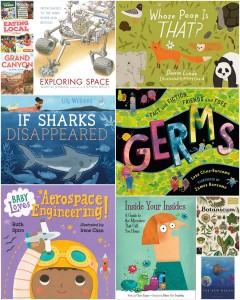
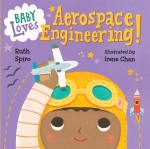 Baby Loves Aerospace Engineering! by Ruth Spiro and Irene Chan (Charlesbridge, 2016)
Baby Loves Aerospace Engineering! by Ruth Spiro and Irene Chan (Charlesbridge, 2016)
- Publisher’s Summary: Accurate enough to satisfy an expert, yet simple enough for baby, this book explores the basics of flight – from birds, to planes and rockets – and ties it all to baby’s world. Beautiful, visually stimulating illustrations complement age-appropriate language to encourage baby’s sense of wonder. Parents and caregivers may learn a thing or two, as well!
- Power Craft Moves: Content-Specific Vocabulary, Lead/Ending, Precise Words, Teaching Tone
- NOTE: This is a board book I’ve been reading to my son. Considering this book is for a young crowd, it is surprisingly accurate and can be used as a mentor for our youngest writers.
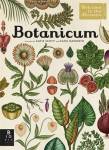 Botanicum by Katie Scott and Kathy Willis (Big Picture Press, 2017)
Botanicum by Katie Scott and Kathy Willis (Big Picture Press, 2017)
- Publisher’s Summary: The 2017 offering from Big Picture Press’s Welcome to the Museum series, Botanicum, is a brilliantly curated guide to plant life. With artwork from Katie Scott of Animalium fame, Botanicum gives readers the experience of a fascinating exhibition from the pages of a beautiful book. From perennials to bulbs to tropical exotica, Botanicum is a wonderful feast of botanical knowledge complete with superb cross sections of how plants work.
- Power Craft Moves: Back Matter, Content-Specific Vocabulary, Precise Words, Teaching Tone, Text Features, Topics and Subtopics
 Eating Local by Laura Perdew (Lerner, 2016)
Eating Local by Laura Perdew (Lerner, 2016)
- Publisher’s Summary: Have you ever shopped for fruits, vegetables, or meat at a local farmers’ market? Or maybe your family picks up a weekly box of fresh fruits and vegetables grown by local farmers in a community supported agriculture (CSA) program. So what does it mean to eat local, why is it a good idea, and how can you participate in your own community?
- Power Craft Moves: Back Matter, Content-Specific Vocabulary, Precise Words, Punctuation to Create Voice, Quotes and Sources, Teaching Tone, Text Features, Topics and Subtopics
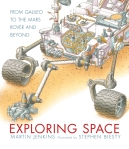 Exploring Space: From Galileo to the Mars Rover and Beyond by Martin Jenkins and Stephen Biesty (Candlewick Press, 2017)
Exploring Space: From Galileo to the Mars Rover and Beyond by Martin Jenkins and Stephen Biesty (Candlewick Press, 2017)
- Publisher’s Summary: For centuries, humans have looked up at the night sky and wondered what it’s like deep in space, far from Earth — and now we’ve begun to find out. We’ve landed on the moon, put robots on Mars, and sent space probes billions of miles to explore the far reaches of our solar system. Told in richly detailed cutaway illustrations by Stephen Biesty and friendly, engaging writing by Martin Jenkins, here is the enthralling story of how we made the great leap into space and what we’ve discovered there. Find out what life is like on the International Space Station, what the chances are that we will ever settle on Mars, where in the solar system we might find alien life, and why visiting other stars will almost certainly remain a dream. Budding astronomers, junior astronauts, and anyone who has ever gazed up at the stars in fascination will pore over this beautifully intricate yet accessible glimpse of the infinite wonders of space.
- Power Craft Moves: Back Matter, Content-Specific Vocabulary, Lead/Ending, Precise Words, Quotes and Sources, Text Features, Topics and Subtopics
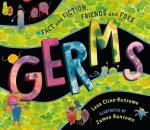 Germs: Fact and Fiction, Friends and Foes by Lesa Cline-Ransome and James Ransome (Henry Holt, 2016)
Germs: Fact and Fiction, Friends and Foes by Lesa Cline-Ransome and James Ransome (Henry Holt, 2016)
- Publisher’s Summary: Come meet the good, the bad, and the ugly—yes, germs!
There’s so much to discover about germs. Did you know that germs make your stomach growl as they break down your food? Or that they can travel the world on anything from fleas and ticks to trains and buses?
Told from the perspective of Sam the Salmonella, this informative picture book introduces young readers to helpful and harmful germs, exploring their discovery; the breakout of historic diseases; the invention of pasteurization, vaccination, and penicillin; and other fascinating details about the world of microscopic organisms. - Power Craft Moves: Back Matter, Content-Specific Vocabulary, Lead/Ending, Precise Words, Punctuation to Create Voice, Teaching Tone
 Grand Canyon by Jason Chin (Roaring Brook Press, 2017)
Grand Canyon by Jason Chin (Roaring Brook Press, 2017)
- Publisher’s Summary: Rivers wind through earth, cutting down and eroding the soil for millions of years, creating a cavity in the ground 277 miles long, 18 miles wide, and more than a mile deep known as the Grand Canyon. Home to an astonishing variety of plants and animals that have lived and evolved within its walls for millennia, the Grand Canyon is much more than just a hole in the ground. Follow a father and daughter as they make their way through the cavernous wonder, discovering life both present and past.Weave in and out of time as perfectly placed die cuts show you that a fossil today was a creature much long ago, perhaps in a completely different environment. Complete with a spectacular double gatefold, an intricate map and extensive back matter.
- Power Craft Moves: Back Matter, Content-Specific Vocabulary, Lead/Ending, Precise Words, Punctuation to Create Voice, Quotes and Sources, Teaching Tone, Text Features, Topics and Subtopics
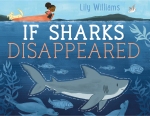 If Sharks Disappeared by Lily Williams (Roaring Brook Press, 2017)
If Sharks Disappeared by Lily Williams (Roaring Brook Press, 2017)
- Publisher’s Summary: A healthy ocean is home to many different kinds of animals. They can be big, like a whale, tiny, like a shrimp, and even scary, like a shark.Even though sharks can be scary, we need them to keep the oceans healthy. Unfortunately, due to overfishing, many shark species are in danger of extinction, and that can cause big problems in the oceans and even on land.What would happen if this continued and sharks disappeared completely?
- Power Craft Moves: Back Matter, Content-Specific Vocabulary, Lead/Ending, Precise Words, Punctuation to Create Voice, Quotes and Sources, Teaching Tone, Topics and Subtopics
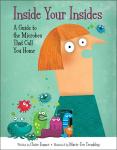 Inside Your Insides: A Guide to the Microbes That Call You Home by Claire Eamer and Marie-Eve Tremblay (Kids Can Press, 2016)
Inside Your Insides: A Guide to the Microbes That Call You Home by Claire Eamer and Marie-Eve Tremblay (Kids Can Press, 2016)
- Publisher’s Summary: “Wherever you go, tiny hitchhikers tag along for the ride,” this intriguing illustrated nonfiction book begins. “The hitchhikers are actually microbes — tiny living things so small that you need a microscope to see them. And every person carries around trillions and trillions of these critters.” Six of the most common “critters” that live in and on our bodies are introduced here: bacteria, archaea, viruses, fungi, protists and mites. Each one has its own preferred environment, and readers will be startled (and likely a little grossed out!) by the many places they live, including the hair follicles on our faces, the folds of our tongues and the lengths of our guts. Just as surprising, only some of them are “bad guys” that cause disease and many of them are actually “good guys” that keep us healthy. There’s even research currently being done on ways to improve or fix our collection of microbes as a way to make us healthier.
- Power Craft Moves: Back Matter, Content-Specific Vocabulary, Lead/Ending, Precise Words, Punctuation to Create Voice, Teaching Tone, Text Features, Topics and Subtopics
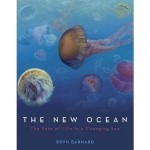 The New Ocean: The Fate of Life in a Changing Sea by Bryn Barnard (Knopf Books, 2017)
The New Ocean: The Fate of Life in a Changing Sea by Bryn Barnard (Knopf Books, 2017)
- Publisher’s Summary: The Earth—our home—is covered mostly with water: the wide, deep, salty, and very blue ocean. It regulates our climate in a way that makes life as we know it possible. This huge ocean is full of an amazing amount of life, most of which is too small to see.But life in the ocean is in trouble. The ocean is becoming hotter, more polluted, and, in places, empty of life. The right amount of warming is good for us, but too much warming is causing shifts that are not good for life in the ocean. Global warming, pollution, and overfishing are creating a New Ocean, in which life is changing drastically.This book tells the stories of the probable fates of six sea dwellers: jellyfish, orcas, sea turtles, tuna, corals, and blue-green algae. What becomes of them may help you understand what becomes of us.
- Power Craft Moves: Back Matter, Content-Specific Vocabulary, Lead/Ending, Precise Words, Punctuation to Create Voice, Quotes and Sources, Teaching Tone, Topics and Subtopics
 Whose Poop Is That? by Darrin Lunde and Kelsey Oseid (Charlesbridge, 2017)
Whose Poop Is That? by Darrin Lunde and Kelsey Oseid (Charlesbridge, 2017)
- Publisher’s Summary: No, don’t say “Ewww.” Ask, “Whose poop is that?” This simple, and yes, charming book asks this question about seven examples of animal poop. By investigating visual clues, young readers can learn to identify the animal through its droppings. For instance, find a sample of poop with bits of bone and tufts of hair. Turn the page to learn it came from a fox!
- Power Craft Moves: Back Matter, Lead/Ending, Precise Words, Repetition, Teaching Tone


I love science picture books and appreciate this list. Plan to pin it to a collection I have of books for children focusing on science topics. Our very future–and especially our children’s–depend on all of us becoming more science knowledgeable. Because of an Acorn and Birds Make Nests are two favorites of mine from the last year.
LikeLiked by 1 person
Fabulous list Stacey. I have read/seen some of these but will add the rest to my list of books to look for.
LikeLike
I love the mix of already published and soon to be published titles! Peaked my interest!
LikeLike
I’m so glad you joined us and shared you weren’t interested in science as a kid but could now find titles of interest where science fits in your life. I have to say, I smiled with Whose Poop Is That? I think my second graders will be full of laughter just from the title.
LikeLike
My must read list just grew! This is a great list of science books, some I’m unfamiliar with and many that I love.
LikeLike
Wonderful collection! Botanicum looks positively gorgeous!
LikeLike
What does the term “back matter” mean?
LikeLike
Back matter is the text that comes after the last page of the story or main text. Examples of back matter include the author/illustrator note, fact pages, historical notes, and source lists.
LikeLike
Your timely book, Craft Moves, has helped me extend my study of mentor texts for my first grade classroom. Also, I’ve enjoyed checking out all the titles from the library and purchasing a few. I will certainly look into these new titles as well.
My All-Time favorite NF book is The Librarian Who Measured the Earth by Kathryn Laskey, It is fabulous biography that celebrates the discoveries one can make by asking questions and applying math and logical thinking to solve earth’s mysteries.
LikeLiked by 1 person
Thank you for your kind words about Craft Moves. I’m delighted to hear that it has had a positive impact on your instruction.
LikeLike
I just read Melissa Stewart’s post. Between hers and yours, I’ve listed so many to look for, Stacey. You’ve made an excellent point about facts. We will cling to them these coming months. Thanks for sharing these wonders!
LikeLike
Stacey: This is a GREAT list — thank you!!!!
Because it is my book’s birthday TODAY, THIS VERY DAY, I’m going to make a plug for an 11th: BAT COUNT. (A copy is heading your way shortly, too…)
LikeLike
I can’t wait to read it, Anna! I can say, “I knew her when it was just a manuscript!”
Congratulations & happy book birthday to you!
LikeLike
Amazing list!! I love Jess Keating’s Pink is for Blobfish.
LikeLike
Thank you! Love these suggestions, and now they are on my WISH LIST! 🙂
LikeLike
Appreciate the new titles! Here are a few of my favorites:
-Pink is For Blobfish
-I am the Most Amazing Sea Creature
-I’m Trying to Like Spiders
LikeLike